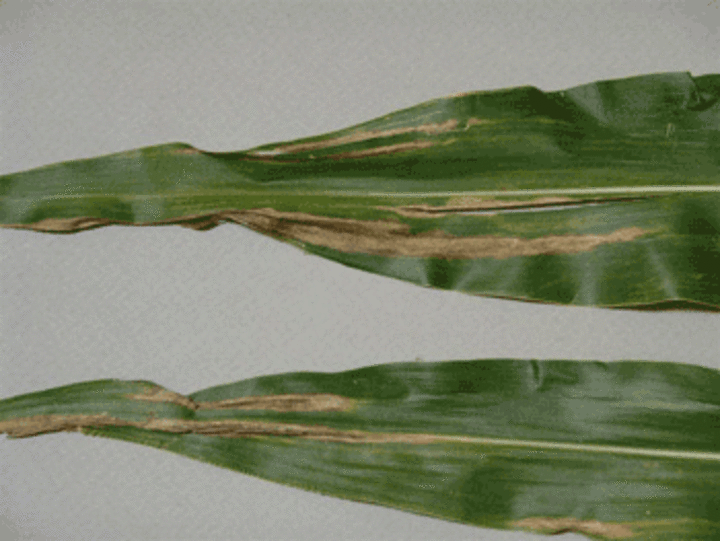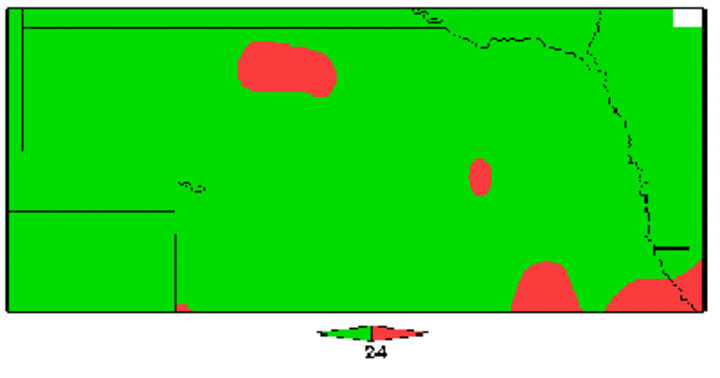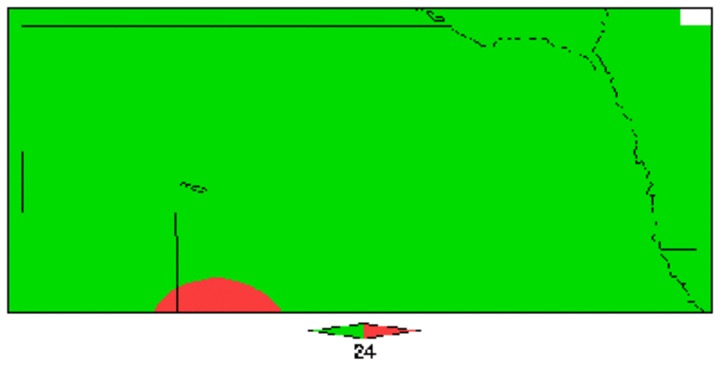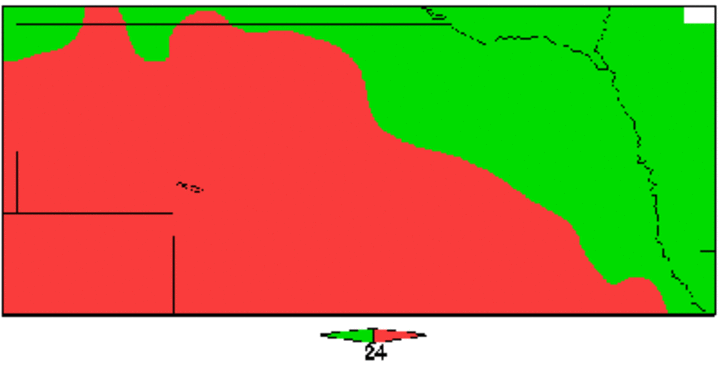
Figure 1. Stewart's wilt lesions from the leaf blight phase.
March 21, 2008
Stewart's bacterial wilt, caused by Pantoea stewartii (formerly known as Erwinia stewartii), has been a problem in parts of Nebraska since the mid 1990s. In 1999 and 2000, Stewart's wilt was identified in at least 27 Nebraska counties scattered across the eastern two-third's of the state.
This disease can cause severe yield losses in susceptible inbreds and popcorn and sweet corn hybrids. But, the bacterium can also be seed-borne and exportation to at least 50 countries is restricted when the disease is confirmed in seed. The pathogen is most commonly spread by the corn flea beetle (Chaetocnema pulicaria) and incidence of this disease has been related to the overwintering survival of the flea beetle.
Stewart's wilt appears in two phases: systemically infected seedlings and leaf blight. The seedling phase is less common than the leaf blight phase, except in sweet corn and some inbreds that tend to be more susceptible. Severely infected plants may develop decaying cavities inside the stalk near the soil line. The leaf blight phase typically develops after tasseling and lesions are usually long, wavy and may be associated with flea beetle feeding injury.

|
| Figure 2. Average temperatures for December 2007 through February 2008. The areas shaded in green and yellow are at low and moderate risk, respectively, for flea beetle survival and Stewart's wilt development in 2008, based on the Steven-Boewe Index. (Map developed by Al Dutcher, Nebraska State Meteorologist, Department of Agricultural Meteorology.) |
Disease Forecasting
Disease forecasting systems for Stewart's wilt have been under development for more than 50 years. Currently, there are at least two predictive models for the leaf blight phase of Stewart's wilt that are based upon the likelihood for flea beetle survival during the previous winter. Both models base their predictions on the average temperatures during December, January, and February. In the 1940s, G.H. Boewe of Illinois modified an earlier model for predicting Stewart's wilt. The predictions for flea beetle survival and Stewart's wilt development in this model are based on the sum of the average temperatures of each of the three winter months. When that temperature index exceeds 90°F, the risk of developing Stewart's wilt is high.
Iowa State University Model
Within the last ten years, the Stevens-Boewe Index was modified by Iowa scientists to improve disease predictions. The new Iowa State Model is based on the average temperature during each individual month. According to this model, the risk for Stewart's wilt development increases according to the number of months (December through February) with an average temperature that exceeds 24°F.
| Table 1. Stevens-Boewe Index to predict the flea beetle survival and Stewart's wilt development. | Table 2. Iowa State University Model for predicting the risk for Stewart's wilt development. It looks at the average temperature for each month from December through February. | ||
| Temperature Index | Risk of Stewart's Wilt | Number of months with >24°F | Predicted Risk of Stewart's Wilt |
|
> 90°F |
High |
0 |
Negligible |
|
80-90°F |
Moderate |
1 |
Low to moderate |
|
|
Low |
2 |
Moderate to high |
|
3 |
High |
||
| Iowa State Model (Nutter et al., 2002. Comput. Electron. Agric. 37:7-14). | |||
Both of these models make disease predictions based on the potential for flea beetle survival. It is important to keep in mind that, historically, flea beetles have not been evenly distributed across Nebraska, and that not all flea beetles will be carrying the bacteria that causes Stewart's wilt. These maps are not an indication of flea beetle or disease distribution, but, based on these models, if flea beetles were present in 2007 and carrying the pathogen, then most of the state is at low risk for flea beetle damage and disease losses due to Stewart's wilt this season.
Controlling Potential Damage
To minimize damage from flea beetles:
- Avoid hybrids or inbreds known to be more susceptible to Stewart's wilt (see seed catalogue or local seed company representative).
- Avoid early planting dates if susceptible inbreds or hybrids are planted.
- Seed treatments containing clothianidin (Poncho) or thiamethoxam (Cruiser) are systemic and provide protection from feeding by flea beetles and other early season soil insects.
- Scout for corn flea beetles on seedling corn. Postemergence treatment may be warranted on dent corn if 50% of plants show severe flea beetle injury (plants look silvery or whitish, or leaves begin to die), and five or more flea beetles per plant are found. If susceptible inbreds or hybrids are grown, an insecticide may be needed when two to three flea beetles per plant are present and 10% of the plants show severe flea beetle injury.
A variety of foliar insecticides also are effective in controlling flea beetles. They include: Lorsban 4E, 2-3 pints per acre; Sevin XLR Plus, 1-2 quarts per acre, Asana XL, 5.8-9.6 fl oz per 1000 row-feet; Lannate LV 0.75-1.5 pints per acre; Pounce 3.2 EC 4-8 fl. oz per acre; Warrior 2.56-3.84 fl. oz per acre), Mustang Max EC 2.72-4.0 oz per acre; Baythroid 2 1.6-2.8 oz per acre. Additional information is available on the UNL Department of Entomology Web site.
It's probably too late to limit risk through hybrid selection since most seed selections already have been made for this season. Minimizing flea beetle damage and careful fertility management may decrease disease severity, especially by avoiding the use of excess nitrogen and phosphorus, nutrients which have been shown to increase disease severity.
For more information, see the UNL Extension NebGuide 1462, Stewart's Wilt of Corn in Nebraska, or the feature article from the American Phytopathological Society, Stewart's Wilt of Corn.
| CropWatch |
| CW Archives |
Tamra Jackson
Extension Plant Pathologist
Bob Wright
Extension Entomologist



